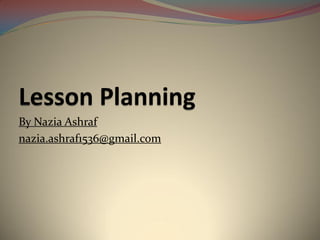
Lesson planning
- 2. Lesson Planning A lesson plan is a road map of the instructions. It helps in achieving goals and objectives, and same can be said on the part of the students. It helps to get rid of problems or avoid them. It gives a reality check of everyday performance. It improves the habit and attitude of the students. It improves the teaching skills. It makes teaching ordinary and easy. It makes the teacher organized during teaching. Lesson planning determines when to include the interesting facts to attract the students’ attention. It enables the teacher to impart the things the students can do at the best of their abilities.
- 3. Process of lesson planning 1. Objectives for student learning 2. Teaching/learning activities 3. Strategies to check student understanding
- 4. Designing a Lesson Plan Introduction Development Conclusion Ask for questions Summarize the main points and explain how they relate to the course Next lesson Recapitalize or one-minute writing about the taught lesson
- 5. Approaches To Lesson Planning basic elements: 3-5 lesson objectives Content to be covered Activities (lecture, group work, problem-solving, etc.) Resources and materials needed (including technology) Timing Out of class work and assessment
- 6. The following classic lesson planning models are most popular in lesson planning. These are 1. Gagne’s frame work for instructional development, 2. Hunter’s seven steps of lesson planning and 3. The 5 E's lesson planning model
- 7. Gagne’s frame work for instructional development Gaining attention Informing learners of the objective Stimulating recall of prior learning Presenting the content Providing learning guidance Providing opportunities to practice Providing feedback (information about how to improve) Assessing performance (exam, tests, papers) Enhancing retention and transfer
- 8. Madeline Hunter’s Seven Steps Lesson Plan Getting Students Ready to Learn Review Protective Set Stating the objective Instruction Input and modeling Checking for Understanding Check for understanding Guided practice (provide feedback without grading) Independent Practice Independent practice (usually for a graded assignment)
- 9. 5 E’s of Lesson Planning Engage Explore Explain Elaborate Evaluate
- 10. Course And Unit Planning Decide a topic Determine objectives Identify learning outcomes- (the desirable results) Determine assessment Design learning experiences and organize material- the content Develop evaluation mechanism-evaluation Information marketing-course description
- 13. Writing up Outcomes Outcomes can be written up in the following format: At the end of this course students should be able to: Define... Summarize... Demonstrate... Analyses... Critique... Integrate... Discussion of Outcomes Discussion of Outcomes Check of Understanding Assessment Planning Content Important Points Evaluation Course Descriptions
- 14. Steps In Lesson Planning Outline learning objectives Develop the introduction Plan the specific learning activities (the main body of the lesson) Plan to check for understanding Develop a conclusion and a preview Create a realistic timeline
- 15. The Lesson Plan Format Title Time List of required materials List of objectives The objectives may be behavioral objectives (what the student can do at lesson completion) or knowledge objectives (what the student knows at lesson completion) The set (bridge-in) Focuses students on the lesson's concept or skills. these include pictures or models and asking leading questions or recalling the previous lessons
- 16. An instructional component Independent practice This practice allows students to extend knowledge and skills by them selves A summary Analysis A continuity component It reviews and relates to the content from the previous lesson.
- 17. Self Assessment Questions Q. 1 It is necessary to plan the lesson before teaching, comment. Q. 2 What is lesson planning? Explain the process of lesson planning? Q. 3 Describe the classical models of lesson planning. Q. 4 Describe the process of course design and planning. Q. 5 Write down the strategies for daily and weekly planning. Q. 6 Highlight the steps involved in lesson planning. Discuss the importance of each step. How teachers can take more benefits in teaching through these steps?
- 18. Q. 7 Why is outlining of goals/objectives necessary before planning a lesson? How are objectives stated in behavioral terms? Q. 8 Highlight the steps of planning “development of instruction”. Q. 9 What is the main body of the lesson, to which a teacher has to focus his/her attention? Q. 10 How teachers can plan and check the students’ understanding of the newly taught lesson? Q. 11 How does conclusion and a preview help a teacher in closing the instruction? Q. 12 Discuss the elements of a lesson plan format. Are these sufficient for planning? How? Q. 13 i) Explain the elements of a lesson plan format. ii) Does the elements covered in a lesson plan format make the teacher fully/completely prepared for teaching? Give suggestions to improve the format.